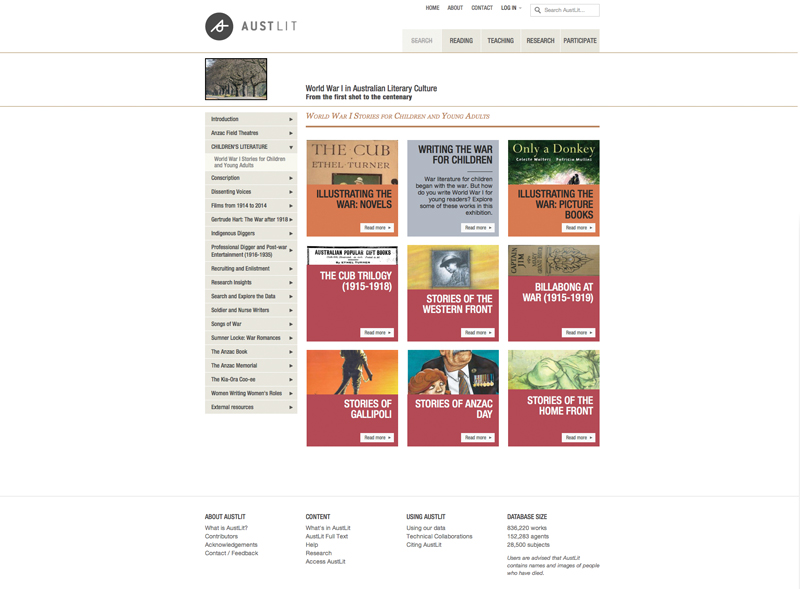Issue 92
Term 1 2015
Explore AustLit; explore our storytelling heritage
Dr Catriona Mills, senior researcher for AustLit looks at how the study of Australian literature can be integrated into the curriculum and the classroom by exploring AustLit the most comprehensive source of information on Australian stories.
Integrating Australian literature into the curriculum and the classroom? Have you explored AustLit, the most comprehensive source of information on Australian story-telling?
What is AustLit?
AustLit is, at its core, a scholarly bibliography of Australian narrative, story-telling, and print culture, an information-rich database of authoritative biographical, bibliographic, critical, and production information about Australian writers and writing about Australia.
AustLit's focus is on creative Australian literature: fiction, drama, poetry, children's and young adult literature, travel writing, autobiography, memoir, biography, essays, Indigenous life stories, and oral history.
The works covered on AustLit date largely from the arrival of European print culture in Australia (c.1788) to the present. AustLit also includes pre- 1788 European imaginings of Australia, such as Gabriel de Foigny's utopian La Terre Australe Connue (1676), as well as the rich dataset of Aboriginal and Torres Strait Islander writings that is BlackWords.
AustLit covers all forms of works (from newspaper to websites), all types of works (from film and television to poetry and short stories), and all genres (from science fiction and fantasy to crime and more).
Currently, AustLit includes records for over 800,000 works and over 150,000 'agents' (a term that includes authors and organisations), while hundreds of records are added or enhanced every month.
As an exploration of a national literature, AustLit's mapping of stories by Australians and about Australia is unique. No other resource attempts to so comprehensively engage with a national literature in the way in which AustLit engages with Australian writing.

'World War I Stories for Children and Young Adults' exhibition landing page
What will you find on AustLit?
You'll find hundreds of thousands of records for authors–authors who were born in Australia, who immigrated to Australia, who emigrated from Australia, who visited Australia and wrote about it, who never visited Australia but wrote about it anyway.
And hundreds of thousands of records for works–works in which Australia is a wasteland, a paradise, a prison, a metaphor, a post-apocalyptic battleground, a suburban wasteland, an urban fairyland, and more. You'll also find ways of accessing the actual work, through library holdings or directly, if it is available online.
Since AustLit is, at its core, a scholarly bibliography, all AustLit work records include authoritative bibliographical details.
In addition, AustLit records can include any or all of the following materials:
- Images: AustLit's database includes provision for images, ranging from book covers (including, in some cases, the many and varied covers of multiple translations or editions) to ancillary materials. For example, records of works in the Australian Popular Theatre dataset often include posters and other images, while records for early Australian films are illustrated with advertisements and publicity stills.
- Full-text versions of the works: Not all of the works listed on AustLit are available in full text, but we do have a rich and growing collection of full-text digitised works. For example, our Children's Literature Digital Resources is a full-text digital repository of rare and popular Australian children's literature from 1830 to 1945.
- Links to online publications: The increasing digitisation of material allows us to provide links to material now available online. For example, as the National Library of Australia digitises more and more Australian periodicals and newspapers, we regularly enrich our records with links to Trove, allowing our users to access the works directly from the AustLit record.
- Secondary material: Part of AustLit's purpose is to collect not only information about the works themselves, but also information on works about those works: critical articles, reviews, and newspaper columns. Links to the records for these secondary works are available from the main work's record.
But beyond the work and author records themselves, AustLit is also increasingly building collections of related material around their research projects. These collections–called exhibitions or trails, as a reflection of their status as curated objects–are accessible pathways into the mass of material available in the database proper.
Take, for example, our most recently launched research project: World War I in Australian Literary Culture, a research project expanding our coverage of the way in which the 1914-1918 war has appeared in literature, film, and other forms of storytelling from the conflict's beginning to the present. At the centre of this project are thousands of enriched records of works and authors influenced by the war.
But the exhibitions that accompany these records allow you to explore these records in different ways. To give only a single example, the exhibition of 'World War I Stories for Children and Young Adults' contains:
- A general overview of World War I literature for children and young adults.
- Slideshows of the covers of novels and picture books.
- Curated lists of World War I themed books organised as 'Stories of the Western Front', 'Stories of Gallipoli', 'Stories of the Home Front', and 'Stories of Anzac Day'.
And that's only a selection of the many exhibitions available on the World War I research page, with much more still to come.
Nor is World War I in Australian Literary Culture the only AustLit research project to be accompanied by these exhibitions, for example, research projects such as the Children's Literature Digital Projects, Asian-Australian Children's Literature and Publishing, and ScreenLit all include rich exhibitions. BlackWords also has a range of informed information trails linking creative works to Aboriginal and Torres Strait Islander nations, or on particular themes such as Aboriginal identity, sporting heroes, life writing, and children's literature.
How can you use AustLit?
With all this material available, what are some of the ways in which AustLit can be used for classroom work?
- Explore a wide range of Australian literary material. AustLit offers the opportunity to simply wander through an extraordinary wealth of material, where you're bound to find something unexpected. Our records of children's fiction alone run to more than 13,500 individual records, from Allan le Jeune Déporté à Botany Bay (roughly, Allan Young Deported to Botany Bay), published in France in 1836, to Grandpa's Big Adventure, which is due to be published by Penguin in 2016.
- Undertake targeted searching for topics. If wandering doesn't suit the occasion, you can undertake focused searches for specific material. One element of the new AustLit is an extraordinarily powerful, extremely malleable, advanced search function. Looking for picture books written by women and first published between 1950 and 1959? AustLit's advanced search function can do that for you. (There are 51.)
- Easily create lists of award-winning and award-nominated works. AustLit regularly records the longlists, shortlists, and winners for a range of Australian and international awards. Using the advanced search function, you can generate lists of award winners for specific years and specific awards. Wondering who was listed for a Gold Inky in 2007? That's one search away–and from the generated list, you can step straight into AustLit's rich records for such work.
- Use our curated exhibitions to explore a range of topics. For example, the slideshow of World War I picture-book covers, mentioned above, serves as a starting place for discussing the iconography of the war. Alternatively, the exhibition on the role of women in war runs from Mary Grant Bruce in World War I to the future war of Tomorrow When the War Began.
So, pop along to AustLit and start exploring. All schools in Australia have free access to AustLit through their State Library and/or National library membership. Find out more.
Image credits
- 'World War I Stories for Children and Young Adults' exhibition landing page. Available at: http://www.austlit.edu.au/austlit/page/7457002
